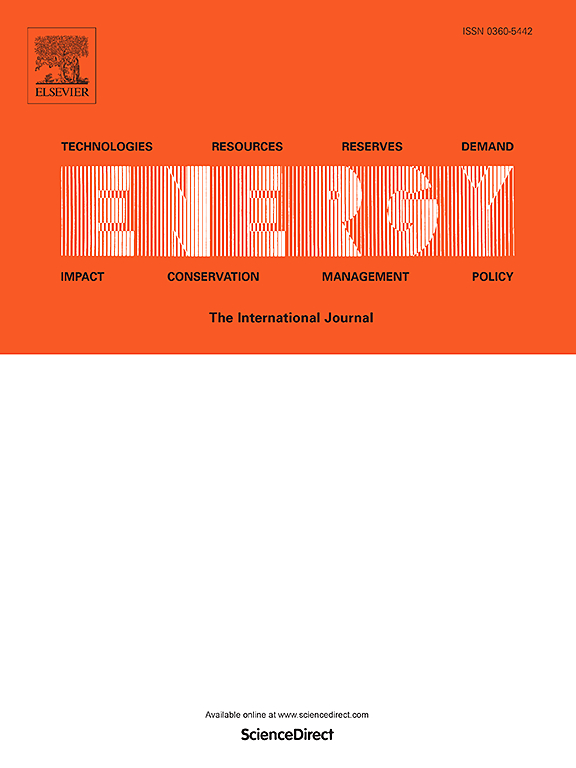酒糟和糖蜜共消化制氢的协同效应:混合成分对工艺稳定性的影响
IF 9
1区 工程技术
Q1 ENERGY & FUELS
引用次数: 0
摘要
通过厌氧消化处理的有机原料越来越被认为是有价值的可再生能源。像酒糟和甘蔗糖蜜这样富含碳水化合物的农业工业生物质可以通过暗发酵产生氢气。本研究利用Simplex Lattice混合液设计对酒糟和糖蜜共发酵产氢进行了评价。进行了批量试验,以分析酒液(V)和糖蜜(M)之间的相互作用,并确定混合成分,以实现最大体积产氢率(VHYCODappl)和生产速率(VHPRCODappl)每施加负载的化学需氧量(CODappl)。试验条件为100%酒液(V100/M0)、75%酒液+ 25%糖蜜(V75/M25)、50%酒液+ 50%糖蜜(V50/M50)、25%酒液+ 75%糖蜜(V25/M75)和100%糖蜜(V0/M100)。结果表明,尽管≥75%的酒糟混合物会导致工艺不稳定,但仍存在协同作用。反应器的碳水化合物去除率为46.49 ~ 74.75%,COD去除率为13.49 ~ 26.53%,挥发性固体去除率为41.58 ~ 50.93%。在V50/M50条件下,产量潜力(3113.27 mL-H2)和产量(10.07 mL-H2/h)最高,VHYCODappl最大值为595.63 mL-H2/g-CODappl/d, VHPRCODappl最大值为50.63 mL-H2/g-CODappl/d,与V25/M75和V0/M100相似。H2产率R2 = 0.98, H2产率R2 = 0.92,具有较强拟合的显著二次模型(p≤0.05)。丁酸是主要代谢物,通过这一途径支持制氢。本文章由计算机程序翻译,如有差异,请以英文原文为准。
Synergistic effects on biohydrogen production from vinasse and molasses co-digestion: Influence of mixture composition on process stability
Organic raw materials processed through anaerobic digestion are increasingly recognized as valuable renewable energy sources. Agroindustrial biomasses like vinasse and sugarcane molasses, rich in carbohydrates, can produce hydrogen via dark fermentation. This study evaluated the co-fermentation of vinasse and molasses for hydrogen production using the Simplex Lattice mixture design. Batch tests were conducted to analyze the interactive effects between vinasse (V) and molasses (M) and to determine mixture compositions for achieving maximum volumetric hydrogen yield (VHYCODappl) and production rate (VHPRCODappl) per applied load in terms of chemical oxygen demand (CODappl). The tested conditions were 100 % vinasse (V100/M0), 75 % vinasse + 25 % molasses (V75/M25), 50 % vinasse + 50 % molasses (V50/M50), 25 % vinasse + 75 % molasses (V25/M75), and 100 % molasses (V0/M100). Results indicated synergistic interactions, though mixtures with ≥75 % vinasse caused process instability. Reactors achieved carbohydrate removal efficiencies of 46.49–74.75 %, COD removal of 13.49–26.53 %, and volatile solids reduction of 41.58–50.93 %. The V50/M50 condition yielded the highest production potential (3113.27 mL-H2) and production rate (10.07 mL-H2/h), with maximum VHYCODappl of 595.63 mL-H2/g-CODappl and VHPRCODappl of 50.63 mL-H2/g-CODappl/d, statistically similar to V25/M75 and V0/M100. Significant quadratic models (p ≤ 0.05) with strong fits (R2 = 0.98 for H2 yield and R2 = 0.92 for H2 production rate) were observed. Butyric acid was the primary metabolite, supporting hydrogen production through this route.
求助全文
通过发布文献求助,成功后即可免费获取论文全文。
去求助
来源期刊

Energy
工程技术-能源与燃料
CiteScore
15.30
自引率
14.40%
发文量
0
审稿时长
14.2 weeks
期刊介绍:
Energy is a multidisciplinary, international journal that publishes research and analysis in the field of energy engineering. Our aim is to become a leading peer-reviewed platform and a trusted source of information for energy-related topics.
The journal covers a range of areas including mechanical engineering, thermal sciences, and energy analysis. We are particularly interested in research on energy modelling, prediction, integrated energy systems, planning, and management.
Additionally, we welcome papers on energy conservation, efficiency, biomass and bioenergy, renewable energy, electricity supply and demand, energy storage, buildings, and economic and policy issues. These topics should align with our broader multidisciplinary focus.
 求助内容:
求助内容: 应助结果提醒方式:
应助结果提醒方式:


